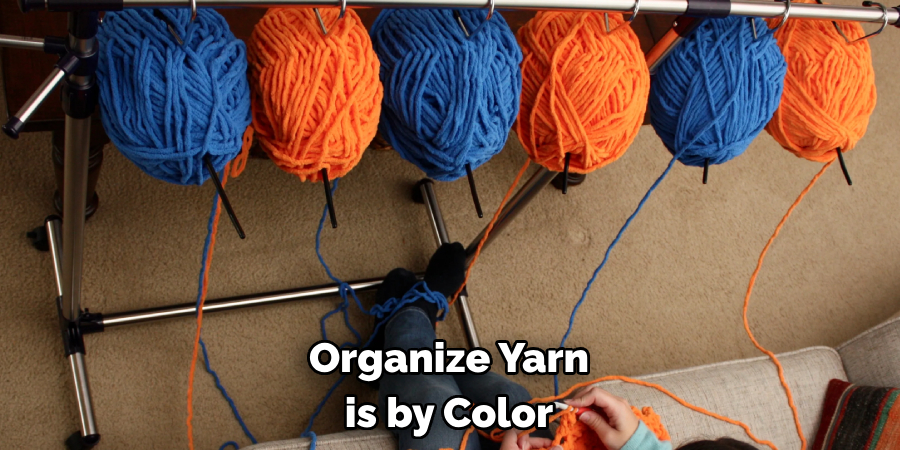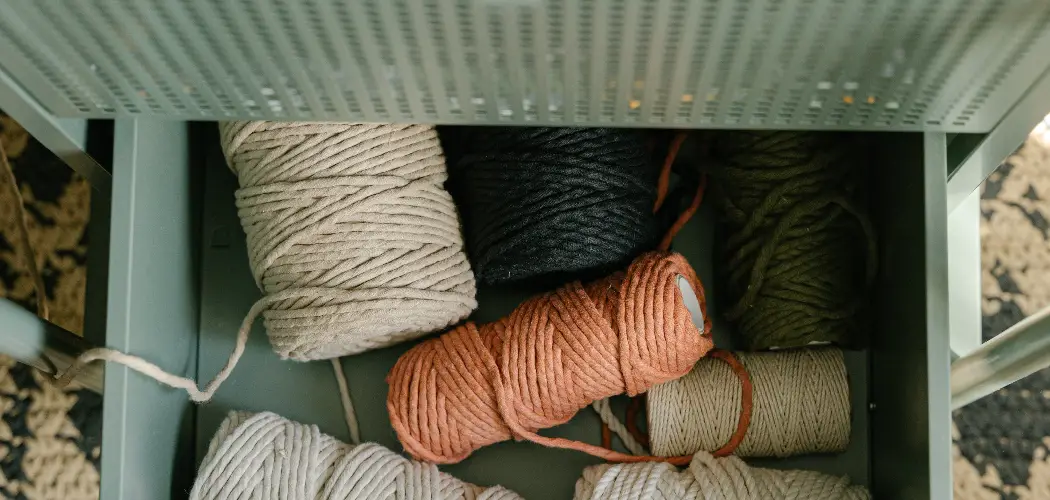Delving into the world of yarn crafting often means amassing a colorful and diverse collection of yarn skeins, balls, and hanks. Keeping this creative treasure trove organized is a crucial step in maintaining a smooth and enjoyable crafting experience. In this guide, we embark on a journey to discover effective strategies on how to organize yarn. From practical storage solutions and color-coded systems to space-saving techniques, we’ll explore methods that not only maintain the integrity of your yarn but also enhance the efficiency of your crafting space.

Whether you’re a seasoned fiber artist or just beginning to build your yarn stash, organizing your yarn can be as satisfying as the creative process itself. Join us as we unravel the secrets to a tidy and inspiring yarn storage system, ensuring that every skein is easily accessible and ready to be transformed into your next masterpiece.
Importance of Organizing Yarn
Yarn is a popular crafting material that is used in knitting, crocheting, and other forms of needlework. It comes in a wide variety of colors, textures, and types such as wool, cotton, acrylic, and more. With so many options available, yarn can quickly become overwhelming if not organized properly.
Organizing your yarn has several benefits. Firstly, it allows you to easily find the specific yarn you need for a project, saving you time and effort. It also prevents duplicating purchases because you can see what yarns you already own. Additionally, organizing your yarn makes it easier to maintain and keep track of your inventory.
So how do you organize your yarn? There are several methods that can work depending on personal preferences and the amount of yarn you have. One popular method is using clear plastic bins or boxes to store yarn by color or type. This allows for easy visibility and access to your yarn collection.
Another option is using shelves or bookcases with dividers to organize your yarn neatly. This can be a great solution for those with limited space, as it utilizes vertical storage. You can also use labeled bins or baskets to categorize and store your yarn, such as separating by weight or brand.
For those with a larger collection of yarn, a dedicated storage system like yarn cabinets or rolling carts may be more suitable. These systems often have multiple compartments and drawers, making it easier to sort and access your yarn.
10 Methods How to Organize Yarn
1. Sort by Color
One of the easiest ways to organize yarn is by color. This method works well for those who like to create colorful projects or have a large variety of colors in their collection. You can either sort your yarn into broad color groups (e.g. red, blue, green) or get more specific and organize by shades within each color group.

2. Group by Weight
Another way to organize yarn is by weight. This method is helpful for those who like to follow patterns that specify a certain weight of yarn. You can use labels or tags to mark the weight category of each skein and then group them together accordingly.
3. Utilize Bins or Baskets
Bins and baskets are great storage solutions for organizing yarn. They come in various sizes and can be stacked or placed on shelves for easy access. You can also label each bin or basket with the type of yarn inside (e.g. cotton, wool, acrylic) for even more organization.
4. Use a Hanging Organizer
A hanging organizer, such as a shoe organizer with pockets, can be repurposed to store and organize yarn. The pockets are perfect for holding skeins and you can easily see what colors you have available.
5. Wind Into Balls
If you prefer working with yarn balls rather than skeins, consider winding your yarn into balls before organizing them. This not only saves space but also makes it easier to grab and go when starting a new project.
6. Store in Drawers
If you have extra drawers in a dresser or cabinet, they can make great storage spaces for organizing yarn. You can use dividers or small containers within the drawers to keep the different types of yarn separated.
7. Hang on Pegboard
For a creative and visually appealing way to organize your yarn, try using a pegboard! You can hang skeins on hooks or use baskets attached to the board for additional storage.
8. Label with Yarn Tags
Yarn tags are a great way to keep track of the details of each skein, such as weight, color, and fiber content. You can attach them to the yarn itself or use them to label bins or baskets for easy identification.

9. Separate by Project
If you like to have different projects going on at once, consider organizing your yarn by project. This way, all the necessary yarn for a specific project is kept together and easily accessible when you’re ready to work on it.
10. Create a Yarn Stash Inventory
Lastly, consider creating an inventory of your yarn stash. This can be done using a spreadsheet or even just a notebook where you list the details of each skein (e.g. brand, color, weight). This will not only help with organization but also prevent you from accidentally buying duplicate skeins in the future.
Things to Consider When Organizing Yarn
When it comes to organizing yarn, there are a few things to keep in mind. Here are some factors you should consider when trying to find the best way to organize your yarn:
- The Types of Yarn You Have: The first thing to think about is the type of yarn you have. Are they all the same weight and texture? Or do you have a mix of different types? This will affect the way you organize them, as some yarns may need to be stored differently than others.
- The Amount of Space You Have: Another important factor is the amount of space you have for storing your yarn. If you have limited space, you may need to get creative with your organization solutions.
- Your Personal Preferences: Everyone has their own way of organizing things, and the same applies to yarn. Think about what works best for you and your knitting or crocheting habits. Do you prefer having all your colors together or organized by weight? Consider what will make the most sense for you.
- Accessibility: It’s also important to consider how easy it will be to access your yarn when you are working on a project. Will your organization system make it easy to find the specific yarn you need? This is especially important if you have a large collection of yarn.
- The Climate: Believe it or not, the climate can also play a role in how you organize your yarn. If you live in a humid area, consider storing your yarn in an airtight container to prevent moisture damage. If you live in a dry climate, it may be best to store your yarn in a breathable container to prevent it from drying out.
Common Mistakes to Avoid When Organizing Yarn
Not Having a System in Place:
Many people simply toss their yarn in a bag or box without any organization, making it difficult to find the specific color or type of yarn they need. To avoid this mistake, create a system for organizing your yarn that works for you. This could include sorting by color, weight, or fiber content.

Forgetting to Label:
Labeling your yarn is a crucial step in organizing it. It can be tempting to skip this step, but if you don’t label your yarn, you may end up with a pile of unidentified skeins that will only cause confusion and frustration. Make sure to label each skein with the color, brand, weight, and fiber content.
Using the Wrong Storage Containers:
Choosing the right storage containers for your yarn is essential. Avoid using plastic bags or cardboard boxes, as they can trap moisture and attract pests. Instead, opt for clear plastic bins with lids that seal tightly to keep your yarn clean and dry.
Not Taking Inventory:
Before organizing your yarn, it’s important to take inventory of what you have. This will not only help you determine how much storage space you need, but it will also prevent you from accidentally buying duplicate skeins. Make a list of all your yarn, including color, weight, and fiber content.
Not Utilizing Vertical Storage:
Many people make the mistake of only organizing their yarn horizontally in bins or baskets. However, utilizing vertical storage options such as shelves or hanging organizers can save space and help you easily see and access your entire collection.
Neglecting to Sort Through Your Stash:
It’s easy to accumulate a large yarn stash over time, but it’s important to regularly go through and declutter. Donate or sell any unused or unwanted yarn to make room for new additions and keep your collection manageable.

Conclusion
In conclusion, organizing yarn may seem like a daunting task at first, but with these simple tips and tricks, you can have your yarn collection organized and easily accessible in no time. Remember to assess your inventory, invest in the right storage solutions, group yarn by color or weight, and label everything for easy identification. Take advantage of unused spaces such as doors, walls, or under-the-bed storage to maximize your space.
With a little bit of effort and consistency, you will have a beautifully organized yarn stash that will make all your crafting projects run smoother and more efficiently. So go ahead and give these methods a try! We would love to hear how they worked for you in the comments below. Thanks for reading, and we hope this has given you some inspiration on how to organize yarn!
Expertise:
Crafting expert with a focus on innovative techniques and diverse materials.
Specialization:
- Textile arts (weaving, embroidery, and fabric dyeing)
- Woodworking and furniture design
- Mixed media and upcycling projects
Recognition:
- Featured in local art exhibits showcasing innovative craft projects
- Collaborated with community organizations to promote crafting workshops
- Received accolades for contributions to sustainable crafting initiatives
Mission:
- To inspire and empower crafters of all levels to discover their creative potential
- Encourages experimentation and self-expression through hands-on projects

